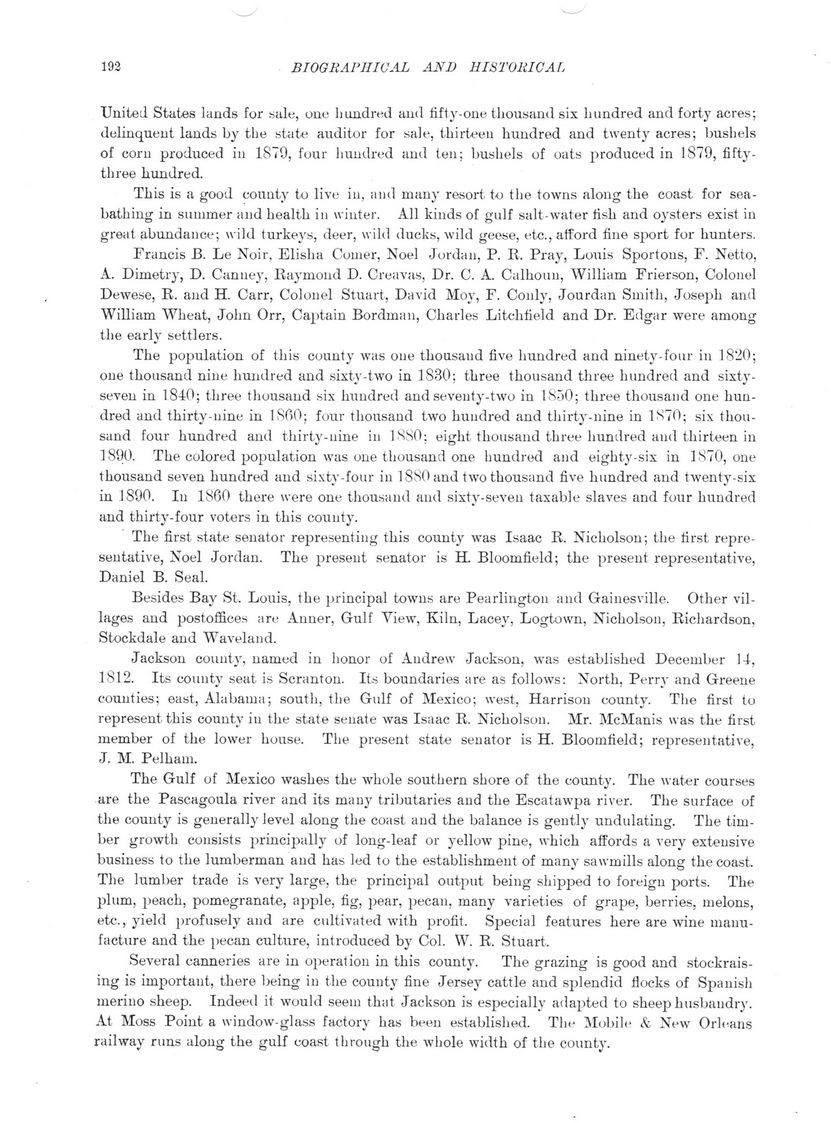This text was obtained via automated optical character recognition.
It has not been edited and may therefore contain several errors.
192 BIOGRAPHICAL AND HISTORICAL United States lands for sale, one hundred and fifty-one thousand six hundred and forty acres; delinquent lands by the state auditor for sale, thirteen hundred and twenty acres; bushels of corn produced in 1879, four hundred and ten; bushels of oats produced in 1879, fifty-three hundred. This is a good county to live in, and many resort to the towns along the coast for seabathing in summer and health in winter. All kinds of gulf salt-water fish and oysters exist in great abundance; wild turkeys, deer, wild ducks, wild geese, etc., afford fine sport for hunters. Francis B. Le Noir, Elisha Coiner, Noel Jordan, P. R. Pray, Louis Sportons, F. Netto, A. Dimetry, D. Canney, Raymond D. Creavas, Dr. C. A. Calhoun, William Frierson, Colonel Dewese, R. and H. Carr, Colonel Stuart, David Mov, F. Conly, Jourdan Smith, Joseph and William Wheat, John Orr, Captain Bordman, Charles Litchfield and Dr. Edgar were among the early settlers. The population of this county was one thousand five hundred and ninety-four in 1820; one thousand nine hundred and sixty-two in 1830; three thousand three hundred and sixty-seven in 1840; three thousand six hundred and seventy-two in lSoO; three thousand one hundred and thirty-nine in 1S60; four thousand two hundred and thirty-nine in 1S70; six thousand four hundred and thirty-nine in 1SS0; eight thousand three hundred and thirteen in 1890. The colored population was one thousand one hundred and eighty-six in 1S70, one thousand seven hundred and sixty-four in 1880 and two thousand five hundred and twenty-six in 1890. In 1860 there were one thousand and sixty-seven taxable slaves and four hundred and thirty-four voters in this county. The first state senator representing this county was Isaac R. Nicholson; the first representative, Noel Jordan. The present senator is H. Bloomfield; the present representative, Daniel B. Seal. Besides Bay St. Louis, the principal towns are Pearlington and Gainesville. Other villages and postoffices are Anner, Gulf View, Kiln, Lacey, Logtown, Nicholson, Richardson, Stockdale and Waveland. Jackson county, named in honor of Andrew Jackson, was established December 14, 1812. Its county seat is Scranton. Its boundaries are as follows: North, Perry and Greene counties; east, Alabama; south, the Gulf of Mexico; west, Harrison county. The first to represent this county in the state senate was Isaac R. Nicholson. Mr. McManis was the first member of the lower house. The present state senator is H. Bloomfield; representative, J. M. Pelham. The Gulf of Mexico washes the whole southern shore of the county. The water courses are the Pascagoula river and its many tributaries and the Escatawpa river. The surface of the county is generally level along the coast and the balance is gently undulating. The timber growth consists principally of long-leaf or yellow’ pine, which affords a very extensive business to the lumberman and has led to the establishment of many sawmills along the coast. The lumber trade is very large, the principal output being shipped to foreign ports. The plum, peach, pomegranate, apple, fig, pear, pecan, many varieties of grape, berries, melons, etc., yield profusely and are cultivated with profit. Special features here are wine manufacture and the pecan culture, introduced by Col. W. R. Stuart. Several canneries are in operation in this county. The grazing is good and stockraising is important, there being in the county fine Jersey cattle and sjjlendid flocks of Spanish merino sheep. Indeed it would seem that Jackson is especially adapted to sheep husbandry. At Moss Point a window-glass factory has been established. The Mobile & New Orleans railway runs along the gulf coast through the whole width of the county.

Hancock County 1 Memoirs-of-Mississippi-excerpt-(003)